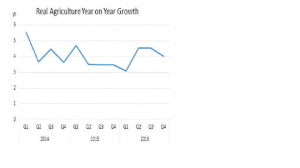
• Agric GDP Grows By 4.11%, Manufacturing Down 4.32%
The National Bureau of Statistics (NBS), on Tuesday released data for Gross Domestic Product (GDP) indicating that Nigeria’s economy in the fourth quarter and full-year 2016 contracted by 1.30% and 1.51% respectively.
Full year 2016 real GDP stood at N67.984tr, a contraction which according to Dr. Yemi Kale, Statistician-General and Chief Executive of the bureau, “reflects a difficult year for Nigeria, which included weaker inflation induced consumption demand, an increase in pipeline vandalism, significantly reduced foreign reserves and a concomitantly weaker currency, and problems in the energy sector such as fuel shortages and lower electricity generation.”
However, the agric sector which contributes 25.49% to overall GDP in real terms was the silver lining for period, growing by 4.11%, higher than 3.72% recorded for 2015; while in Q4, it contributed 25.49%, higher than its share of 24.18% in the corresponding quarter of 2015, but less than its share in the previous quarter of 28.65%. 
The manufacturing sector in real terms contracted by a higher 4.32%, compared to a decline of 1.46% recorded in 2015, reflecting “a number of challenges face by manufacturing in 2016, such as higher costs of imported inputs as a result of the exchange rate, and higher energy costs as a result of a fall in electricity generation, and more expensive fuel.”
Also, in 2016 the financial services sector (finance and insurance) contracted by 4.56% in real terms (compared to a growth of 7.12% in 2015), driven by a –5.57% contraction in financial institutions real GDP.
The construction sector contacted by 5.95% in real terms, compared to a growth of 4.35% in 2015.
Meanwhile, according to the data, the 2016 last quarter real term GDP which fell from N18.533 trillion in the corresponding period of 2015 to N18.292 trillion, was the fourth consecutive quarterly decline, even as the bureau noted that it ”was less severe than the (2.24%) decline recorded in the previous quarter.”
According to a six-year data, in 2011, Nigeria’s GDP rose by 5.31%, dropping to 4.21% the following year, before climbing to 5.49% in 2013, peaking for the period at 6.22% in 2014 and then taking a significant plunge to 2.79%; and then straight into negative territory at 1.51% last year.
In the final quarter of 2015, Nigeria’s GDP had grown by 2.11%. Quarter on quarter,
real GDP increased by 4.09%, which partly reflects seasonal factors as well as a rise in the general price level.
Nominal GDP in the fourth quarter, he said, stood at N29.292bn at basic prices, which represents year-on-year nominal growth of 12.97%, while for the full-year, it stood at N101.598bn, up from the previous N94.144bn.
The Q4 figure, he continued, was “in contrast to real growth, this is 5.84% points higher than the rate recorded in the same quarter of 2015, implying that the GDP deflator increased faster than the earlier period.”
According to the report, 2016 full-year oil production was estimated at 1.833 million barrels per day, down from 2.13mbpd in 2015, which is still lower than the nation’s 2.2mbpd Organisation of Petroleum Exporting Countries (OPEC) quota
“This reduction has largely been attributed to vandalism in the Niger Delta region. As a result, the sector contracted by -13.65%; a more significant decline than that in 2015 of -5.45%. This reduced the oil sectors share of real GDP to 8.42% in 2016, compared to 9.61% in 2015.”
Specifically, the nation’s production capacity was at its highest of 2.18mbpd in the 2015 Q1, after which it dropped to 2.05mbpd, before rising to 2.16mbpd and thereafter began a gradual decline, touching a low of 1.63mbpd in the 2016 Q3, rising to 1.9mbpd in Q4.
For the year, non-oil sector declined by -0.22% in real terms, compared to a growth rate of 3.75% in 2015, a difference of 3.97% points, with the real estate as the sector that weighed down the number most, after declining by -9.27% and contributed to –0.77% points to year on year growth in total real GDP.
“However, Manufacturing, Construction and Trade also made significant downwards contributions, ameliorated slightly by continuing strong growth in Agriculture (especially Crop Production).”
While oil sector GDP contributed only 7.15%, the non-oil sector contributed 92.85%, on a quarterly basis, oil GDP have been negative since Q4 2015, when it stood at -8.28%, improving significantly to -1.89%, before worsening to -17.48% and then hitting a peak of 22.01%, before dropping to 12.38%.
The non-oil GDP began with a positive 3.14%, dropping to -0.18% in the following quarter; then -0.38% in 2016 Q2; 0.03% in the next quarter; and then -0.33% in Q4.





